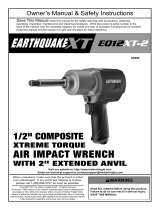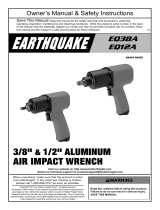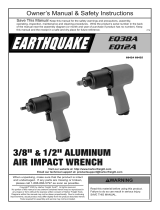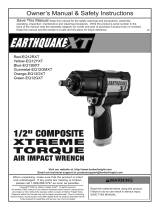Northern Industrial Tools 1202S209 User manual
- Category
- Power tools
- Type
- User manual
This manual is also suitable for

Page
2 of 8
Thank you very much for choosing a NORTHERN TOOL + EQUIPMENT CO., INC. Product! For
future reference, please complete the owner’s record below:
Model: _______________ Purchase Date: _______________
Save the receipt, warranty and these instructions. It is important that you read the entire manual
to become familiar with this product before you begin using it.
This machine is designed for certain applications only. Northern Tool + Equipment cannot be
responsible for issues arising from modification. We strongly recommend this machine is not
modified and/or used for any application other than that for which it was designed. If you have
any questions relative to a particular application, DO NOT use the machine until you have first
contacted Northern Tool + Equipment to determine if it can or should be performed on the
product.
For technical questions please call 1-800-222-5381.
Technical Specifications
Item
Description
Square Drive
3/8"
Free Speed
13,000 RPM
Max. Torque
85 ft.-lbs.
Air Consumption
5.5 CFM
Air Inlet Diameter
1/4"- 18NPT
Min. Hose Size
3/8"
Max. air pressure
90 PSI
WARNING: Read and understand all instructions. Failure to follow all instructions listed
below may result in electric shock, fire and/or serious injury. The term “power tool” in all of the
warnings listed below refers to your pneumatic tool.
WARNING: The warnings, cautions, and instructions discussed in this instruction
manual cannot cover all possible conditions or situations that could occur. It must be
understood by the operator that common sense and caution are factors which cannot be built into
this product, but must be supplied by the operator.
SAVE THESE INSTRUCTIONS
WORK AREA
Keep work area clean, free of clutter and well lit. Cluttered and dark work areas can cause
accidents.
Do not use your tool where there is a risk of causing a fire or an explosion; e.g. in the
presence of flammable liquids, gasses, or dust. Power tools create sparks, which may ignite the
dust or fumes. Do not expose air tools to rain or wet conditions.
Keep children and bystanders away while operating a power tool. Distractions can cause you
to lose control, so visitors should remain at a safe distance from the work area.
Be aware of all power lines, electrical circuits, water pipes and other mechanical hazards in
your work area, particularly those hazards below the work surface hidden from the operator’s
view that may be unintentionally contacted and may cause personal harm or property damage.

Page
3 of 8
Be alert of your surroundings. Using power tools in confined work areas may put you
dangerously close to cutting tools and rotating parts.
PERSONAL SAFETY
Stay alert, watch what you are doing and use common sense when operating a power tool. Do
not use a power tool while you are tired or under the influence of drugs, alcohol or medication. A
moment of inattention while operating power tools may result in serious personal injury.
Dress properly. Do not wear loose clothing, dangling objects, or jewelry. Keep your hair,
clothing and gloves away from moving parts. Loose clothes, jewelry or long hair can be caught
in moving parts. Air vents often cover moving parts and should be avoided.
Use safety apparel and equipment. Use safety goggles or safety glasses with side shields
which comply with current national standards, or when needed, a face shield. Use as dust mask
in dusty work conditions. This applies to all persons in the work area. Also use non-skid safety
shoes, hardhat, gloves, dust collection systems, and hearing protection when appropriate.
Avoid accidental starting. Do not carry the power tool with your finger on the switch. Ensure
the switch is in the off position before plugging tool into power outlet. In the event of a power
failure, while a tool is being used, turn the switch off to prevent surprise starting when power is
restored.
Do not overreach. Keep proper footing and balance at all times.
Remove adjusting keys or wrenches before connecting to the power supply or turning on the
tool. A wrench or key that is left attached to a rotating part of the tool may result in personal
injury.
PNEUMATIC TOOL USE
Do not force the tool. Tools do a better and safer job when used in the manner for which they
are designed. Plan your work, and use the correct tool for the job.
Never use a tool with a malfunctioning switch. Any power tool that cannot be controlled with the
switch is dangerous and must be repaired by an authorized service representative before using.
Check for misalignment or binding of moving parts, breakages of parts, damaged air hose (not
included), and any other condition that may affect the tool’s operation. If damaged, have the tool
serviced before using. Many accidents are caused by poorly maintained tools.
Disconnect air supply from tool and place the switch in the locked or off position before
making any adjustments, changing accessories, or storing power tools. Such preventive safety
measures reduce the risk of starting the power tool accidentally.
Secure work with clamps or a vise instead of your hand to hold work when practical. This
safety precaution allows for proper tool operation using both hands.
Store idle tools. When tools are not is use, store them in a dry, secure place out of the reach of
children. Inspect tools for good working condition prior to storage and before re-use.
Use only accessories that are recommended by the manufacturer for your model.
Accessories that may be suitable for one tool may create a risk of injury when used on another
tool.
Keep guards in place and in working order.
Never leave tool running unattended.
Compressed air only. Only use clean, dry and regulated compressed air at no more than 90
PSI to power this tool. Never use oxygen, carbon dioxide or any other bottled gas as a power
source for this tool.

Page
4 of 8
Use proper size and type air pressure line and fittings. The recommended air line for this tool
is 3/8" delivering no more than 90 PSI. Recommended air inlet size is 1/4"- 18NPT.
Use air hoses rated for safe operation of the tool. Air hoses rated for a maximum of 150 PSI or
greater must be used with this tool.
Make sure the hose is free of obstructions or snags. Entangled hoses can cause loss of
balance or footing.
ASSEMBLY
Figure 1. Optimal pneumatic set-up.
NOTE: For best performance, it is recommended to incorporate an inline filter, regulator, and oiler
similar to the set-up seen in Figure 1. Everything needed for the perfect set-up can be found at
Northern Tool + Equipment.
1. You will need to attach a standard 1/4" air connector (not included) to the air inlet (29) of the
tool. First wrap the threaded portion of the 1/4" air coupler with pipe thread tape. Then thread
the air coupler into the air inlet (29), and tighten securely.
2. Turn on the air compressor, set the air pressure regulator of the compressor to 90 PSI, and
connect the 3/8" air compressor hose to the air connector on air impact wrench with a quick
connect coupler (not included).
WARNING: Do not connect pneumatic tool to compressed air in which the pressure
exceeds 90 PSI. Damage to your tool and possible personal injury may result.
NOTE: If you are not using an automatic oiler system, before operation, add a few drops of
pneumatic tool oil to the airline connection. Add a few more drops after each hour of continual use.
3. Check the air line and its connections for air leaks, and repair them before using this tool.
4. Turn off the compressor and disconnect the air source hose in preparation to attach the
sockets into the impact wrench.
OPERATING INSTRUCTION
WARNING: Always disconnect from the air source before examining or changing sockets.
1. Select the appropriate size 3/8" drive socket, and attach the socket onto the wrench’s anvil.
2. Turn the air regulator (32) in the direction indicated by the “H” arrow on the regulator to
increase the power. Turn it toward the “L” arrow to decrease the power.

Page
5 of 8
3. Set the forward/reverse lever to the left, so that the anvil turns clockwise (forward).
4. Turn on the air compressor, confirm the compressor’s pressure regulator is set to 90 PSI, and
connect the compressor hose to the air ratchet wrench at the air inlet (29).
5. Place the socket (not included) over the nut you wish to tighten.
6. Grip the impact wrench firmly with two hands and gently squeeze the trigger.
7. When the nut is tightened, release the trigger. Turn off the air compressor and disconnect the
hose.
8. If necessary, check the recommended torque specification for the nut and use a manual
torque wrench to achieve the proper setting.
WARNING: If the impact wrench cannot tighten, or loosen, the nut to your satisfaction, do
not raise the air pressure on the compressor over 90 PSI. Pressures above 90 PSI will strip the
workpiece and damage the tool, potentially causing the tool to fail, causing serious injury. Use other
appropriate methods and tools to tighten the nut.
Loosening
9. Set the forward/reverse ever to the right, so that the anvil turns counterclockwise (reverse).
10. Place the socket (not included) over the nut you wish to loosen.
11. Grip the impact wrench firmly with two hands and gently squeeze the trigger.
12. When the nut is loosened, release the trigger. Turn off the air compressor and disconnect the
hose.
MAINTENANCE
WARNING: Make sure this tool is disconnected from its air source and squeeze the trigger
to release all compressed air in the tool before attempting any maintenance, cleaning, or
inspection.
Maintain your tools. It is recommended that the general condition of any tool be examined
before each use. Keep your tools in good repair by adopting a program of conscientious repair
and maintenance in accordance with the recommended procedures found in this manual. If any
abnormal vibrations or noise occurs, turn the tool off immediately and have the problem
corrected before further use. Have necessary repairs made by qualified service personnel.
Keep cutting tools sharp and clean. Properly maintained cutting tools with sharp cutting
edges are less likely to bind and are easier to control. Keep handles dry, clean, and free from oil
and grease.
Cleaning. Use a clean cloth to remove all dirt, oil, and grease from the tool after each use. If
necessary, you may use a mild detergent. Do not use solvents, as damage to the tool may
occur. Do not immerse the tool in any liquids.

Page
7 of 8
PARTS LIST
Part No.
Description
Qty.
Part No.
Description
Qty.
1
Motor
1
23
Cap Washer
4
2
Oil Seal
1
24
Screw
1
3
O-ring
1
25
Valve Pin
1
4
Socket Retainer
1
26
O-ring
1
5
Spindle Bush
1
27
Steel Ball
1
6
Anvil Shank
1
28
Spring
1
7
Driver Cam
1
29
Air Inlet
1
8
Hammer Dog
1
30
Spring
1
9
Hammer Cage
1
31
O-ring
1
10
Hammer Pin
1
32
Air Regulator
1
11
Front End Plate
1
33
Pin
1
12
Oil Seal
1
34
Trigger
1
13
Ball Bearing
1
35
Pin
1
14
Rotor
1
36
Forward/Reverse
Lever
1
15
Rotor Blade
6
37
O-ring
2
16
Cylinder
1
38
Reverse Valve
1
17
Dower Pin
1
39
Screw
1
18
Rotor End
1
40
Pin
1
19
Hammer Cage
1
41
Spring
1
20
Screw
1
42
Deflector
1
21
Housing Cap
1
43
Rubber Nose Guard
1
22
Washer
4
44
Rubber Cover
1

Page
8 of 8
WAR NING
Some dust created by power sanding, sawing, grinding, drilling, and other construction activities contains
chemicals known to the State of California to cause cancer, birth defects or other reproductive harm.
Some examples of these chemicals are:
• lead from lead-based paints,
• crystalline silica from bricks and cement and other masonry products, and
• arsenic and chromium from chemically-treated lumber.
Your risk from these exposures varies, depending on how often you do this type of work. To reduce your
exposure to these chemicals: work in a well ventilated area, and work with approved safety equipment,
such as those dust masks that are specially designed to filter out microscopic particles.
Northern Tool + Equipment Co.
2800 Southcross Drive West
P.O. Box 1499 Burnsville, MN 55337-0499
Made in CHINA
-
 1
1
-
 2
2
-
 3
3
-
 4
4
-
 5
5
-
 6
6
-
 7
7
-
 8
8
Northern Industrial Tools 1202S209 User manual
- Category
- Power tools
- Type
- User manual
- This manual is also suitable for
Ask a question and I''ll find the answer in the document
Finding information in a document is now easier with AI
Related papers
Other documents
-
Klutch Heavy-Duty Air Ratchet Wrench Owner's manual
-
 Earthquake XT 63800 Owner's manual
Earthquake XT 63800 Owner's manual
-
 EarthQuake 68425 Owner's manual
EarthQuake 68425 Owner's manual
-
 EarthQuake Item 68425-UPC 792363684255 Owner's manual
EarthQuake Item 68425-UPC 792363684255 Owner's manual
-
Central Pneumatic IMPACT SET 33567 User manual
-
Steel Core 40811 User manual
-
Klutch Heavy-Duty Air Impact Wrench Owner's manual
-
 Earthquake XT Item 57157-UPC 792363571579 Owner's manual
Earthquake XT Item 57157-UPC 792363571579 Owner's manual
-
Central Pneumatic Item 62355-UPC 193175330840 Owner's manual
-
Harbor Freight Tools 68429 User manual

















